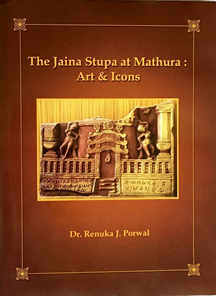Author: Renuka J. Porwal
Publisher: Prachya Vidyapeeth, Shajapur
Year: 2016, Edition: First, Pages: 304, Price: INR 900/-
Reviewer: Gauri Bedekar

Author: Renuka J. Porwal
Publisher: Prachya Vidyapeeth, Shajapur
Year: 2016, Edition: First, Pages: 304, Price: INR 900/-
Reviewer: Gauri Bedekar
The book has seven chapters followed by an exhaustive bibliography of primary and secondary sources along with 158 illustrations, including sculptures and inscriptions.
The first chapter highlights the place of Mathura in Jainism. This introductory chapter begins with a brief overview of Vedic tradition, Śramaṇic tradition, the union of Vedic and Śramaṇic traditions, introduction of Jainism, and significance of Mathura in Indian religious traditions. The chapter also includes discussion of historical background of Mathura including invasions by rulers like Hunas, Gazni, Sikandar Lodi, etc. After discussing the grandeur of Mathura as evidenced from literary and archaeological sources, Porwal briefly discusses the topics of sculptural and architectural remains discovered at Mathura and the ‘Devanirmita Stūpa’ (stūpa created by Gods) which are elaborated in later chapters.
The second chapter traces the tradition of caitya (place of worship) and stūpa (sacred structure which generally enshrines the remains of a holy person) in Jainism. Porwal lists references of stupa from texts like Yājñavalkya Smṛti, Mahābhārata, Rāmāyaṇa, Arthaśāstra as well as in Jain literature including a detailed description of Jinaprabhasūri’s account of the stūpa at Mathura. The chapter includes a detailed discussion on ‘thūba/stūpa’, ceiya/caitya based on āgamas (Jain canonical texts) and their commentaries and explanatory texts like ‘niryuktis’ and ‘cūrṇis’.
The author discusses the stūpa at Mathura based on evidence from literary tradition and remains from archaeological excavation. Other interesting topics discussed in this chapter include an account of a dispute between Jains and Buddhists over stūpas and its reconciliation; and accounts of historians and travellers from medieval period, describing Mathura.
The third chapter begins with brief exploration on Mathura school of art with Greek and Hellenic influences. The author discusses iconography of Jain images, concepts like 24 Tirthankaras and sarvatobhadra, evolution of Jain images influenced by Mathura school of art and veneration of auspicious symbols like the aṣṭamaṅgala in Jainism. The chapter includes description of some of the sculptures discovered at Mathura with their salient features viz. ayāgapaṭas (stone votive tablets) mahāpuruṣa lakṣnṇas (characteristics of great or illustrious men) of the jina images, doner inscriptions, etc.
In the fourth chapter, Porwal traces the development of deities in Jain pantheon. Based on numerous images discovered from the Kaṅkālī Ṭīlā excavation and Mathura region, the chapter traces veneration of yakṣa-yakṣī and other minor deities including their references in scriptures, depiction of deities like Harinaigameśi and concepts like transfer of embryo of Mahāvīra as described in some scriptures, development of goddess Sarasvati in scriptures and images. The chapter also explores tantra in Jainism.
The fifth chapter is dedicated to other excavated artefacts of Mathura. As the author states ‘Mathura contributes a series of artefacts unearthed from Kaṃkāli Ṭīlā, comprising of images, ayāgapaṭas, railing pillars, śālabhaṅjikās (woman and tree motif represented in sculpture), door lintels, door jambs, toraṇas (archway), ornamental bosses, blocks narrating life incidents of Jinas, etc’ (p.131). The chapter also explores iconography of ayāgapaṭas, references of ayāgapaṭas in texts and classification of ayāgapaṭas as well as concept of śālabhaṅjikā in literature and sculptures. The chapter provides descriptions of the ayāgapaṭas, śālabhaṅjikā, toraṇas, and narrative sculptures found at Mathura.
Donative inscriptions found at Mathura have been crucial in understanding history of Jainism in the region. The sixth chapter provides a comprehensive list of inscriptions with translation, characteristics of these inscriptions and social, religious, and economic aspects reflected in these inscriptions. The author very thoughtfully provides background information necessary for this understanding including roots of gaṇa, (monastic unit or division of mendicant lineage) kula (small group centring on a religious teacher), and śākhā (branch) of preceptors, the Sthavirāvalī / Therāvalī (chronological lineage of early ascetics in tradition of Mahavira) expounded in Kalpasūtra, Jain councils, classification of āgamas, and antiquity of agamic literature. The chapter also briefly discusses evolution of Namokāra Mantra to its present form.
The final chapter discusses spread of Jainism to different parts of India.
This book briefly touches upon many significant aspects of religious, literary and art history of Jainism. The author has taken great efforts to provide references from literary epigraphic sources to substantiate the data. It is a must read for students of Jainology and those interested in understanding significance of Mathura in Jain tradition.
gauri.bedekar@shrifirodiatrust.org
Gauri Bedekar is working as Assistant Researcher on the project of ‘Firodia Institute of Philosophy, Culture and History’. Visiting faculty for Indology at Tilak Maharashtra Vidyapeeth, Pune since 2010. Visiting faculty for Material Culture Studies at Master of Architecture at Sinhagad College of Architecture since 2016.